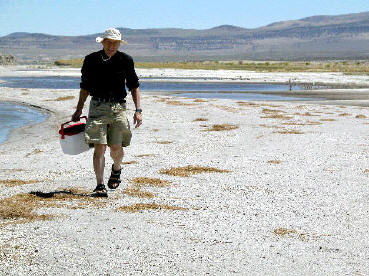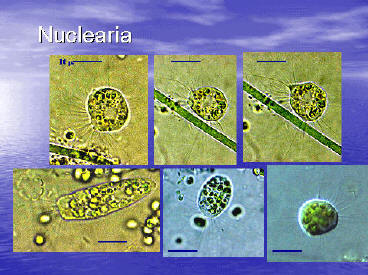The Range of Protists
in Mono Lake
LLOYD A. DAVIDSON and ARDEN E. DAVIDSON, Biology Department,
Loyola University, 6525 N. Sheridan Rd., Chicago, IL 60626
 In spite of the controversies surrounding the environmental
deterioration of Mono Lake, and the significant amount of research
being done on this remarkably productive body of water, nobody has
ever attempted to survey the protists that live beneath its surface.
Beginning in July of 2003, we have been trying to remedy this
situation and spent two months there studying the protistan species
that reside in its waters and since then have been receiving regular
sample collections for analysis. Based on the metazoan eukaryotes that
live in this lake, which include only Artemia monica,
Ephydra hians, rare rotifers and a nematode, we were warned to
expect the lake to be depauperate of protists as well.
In spite of the controversies surrounding the environmental
deterioration of Mono Lake, and the significant amount of research
being done on this remarkably productive body of water, nobody has
ever attempted to survey the protists that live beneath its surface.
Beginning in July of 2003, we have been trying to remedy this
situation and spent two months there studying the protistan species
that reside in its waters and since then have been receiving regular
sample collections for analysis. Based on the metazoan eukaryotes that
live in this lake, which include only Artemia monica,
Ephydra hians, rare rotifers and a nematode, we were warned to
expect the lake to be depauperate of protists as well.
However, we are happy to report that, while not as rich in species as most freshwater lakes, Mono Lake does support a robust population of phagotrophic and heterotrophic protozoa in addition to its many species of unicellular algae, including diatoms. It contains ciliate species representing at least the genera Cyclidium, Frontonia, Lacrymaria, Litonotus, Euplotes and Aspidisca, and the stalked suctorian Podophrya. Additionally, there are species representing the heliozoa, helioflagellates, at least two species of choanoflagellates, Pseudobodo, Cercomonas and Chilomastix, among other flagellates. The gymnamoebae are represented by Vanella, Nuclearia, Mayorella and Hartmanella, and, from the Heterolobosea, probable Vahlkampfia and Gruberella species, along with a species of Pseudodifflugia. Work on these species is still very much in its preliminary stages and a more detailed analysis and identification of the protists found in this extreme environment is advancing. This work was partially supported by an NSF grant (MCB 99-77901) to Robert Jellison.

